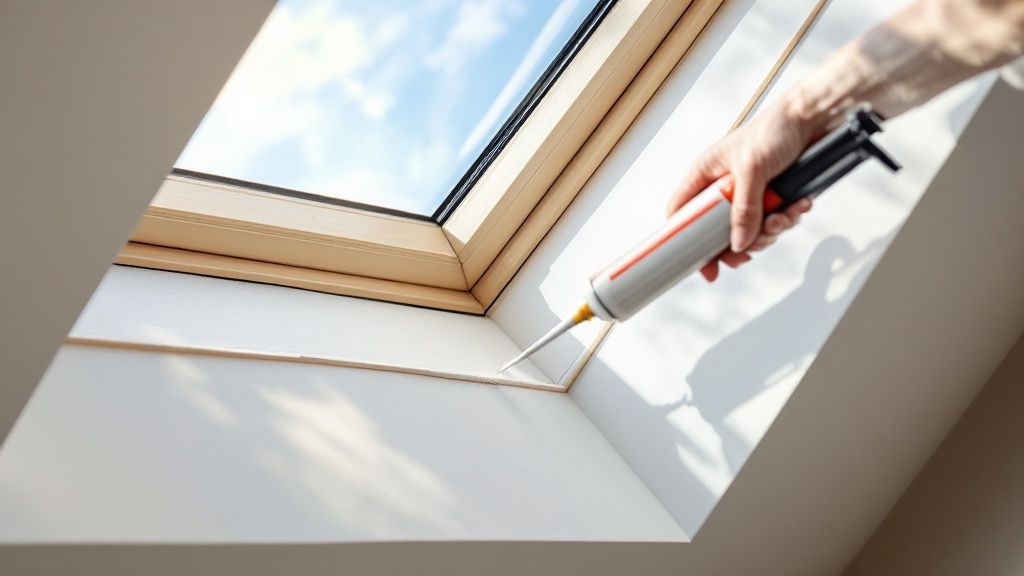
Understanding Building Codes for Your Skylight Project
Before embarking on your skylight sealing project, it’s crucial to familiarize yourself with the relevant Australian building codes. Compliance not only guarantees a watertight seal but also ensures the safety and energy efficiency of your home. Understanding these codes empowers you to make informed decisions, leading to a professional and long-lasting result.
The National Construction Code (NCC) and NatHERS
The National Construction Code (NCC) serves as the principal set of technical regulations for building work in Australia. While the NCC doesn’t specify a particular air leakage rate, it emphasizes performance requirements, often assessed using the Nationwide House Energy Rating Scheme (NatHERS). Effective sealing plays a vital role in your home’s overall energy efficiency, directly impacting its NatHERS rating. A well-sealed skylight, much like a well-sealed window, prevents heat loss in winter and heat gain in summer.
Proper skylight sealing in Australia involves adhering to local building codes and energy standards. The NCC’s performance requirements, often assessed using NatHERS, encourage effective sealing. Learn more about energy efficiency and airtightness.
AS 1288: Safety First
Safety is paramount, especially with overhead installations like skylights. AS 1288, the Australian Standard for glass in buildings, mandates safety glass for all overhead glazing. This is critical for protection against potential breakage and injury. Safety glass minimizes the risk of dangerous shards scattering if, for instance, a tree branch falls on your skylight.
Climate Zone Considerations
Australia’s diverse climates, from Darwin’s tropical humidity to Hobart’s cooler temperatures, necessitate tailored sealing approaches. Your chosen sealant and flashing materials must withstand the specific regional challenges. This could involve choosing a UV-resistant sealant in sunny Queensland or a flexible sealant for Tasmania’s cold winters.
Understanding these building codes equips you to approach your skylight sealing project with confidence. Adhering to these standards creates a durable and effective seal while enhancing your home’s safety and energy efficiency.
Getting the Right Tools and Materials for Success
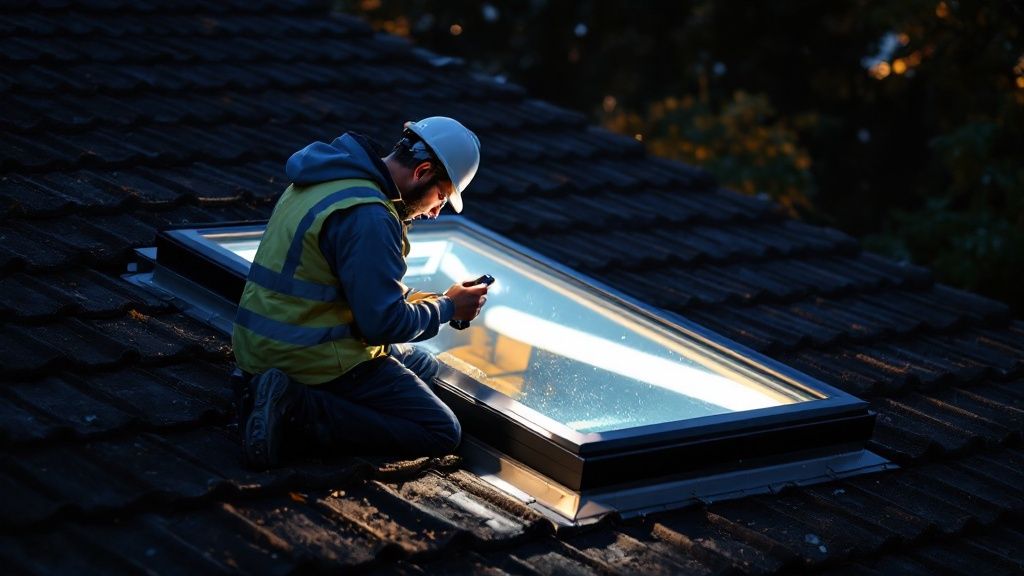
Successfully sealing a skylight begins with having the right tools and materials at your disposal. This involves understanding the various product options available and selecting those best suited to withstand Australia’s often harsh climate. Investing in quality materials upfront can prevent costly repairs and replacements later on, saving you both time and money in the long run.
Essential Tools For The Job
Before you begin your skylight sealing project, gather these essential tools:
- Caulking gun: This tool ensures smooth and even application of your chosen sealant.
- Utility knife: A sharp utility knife is essential for cutting sealant tubes, cleaning away old sealant, and trimming flashing.
- Putty knife: Use a putty knife to remove old sealant and create smooth surfaces for optimal adhesion.
- Safety glasses: Protect your eyes from debris and sealant with a good pair of safety glasses.
- Roofing ladder and safety harness: Safe access to your skylight is paramount. A sturdy roofing ladder and safety harness are crucial, especially considering Australian safety regulations.
Choosing The Right Sealant
The sealant you choose plays a vital role in creating a long-lasting, watertight seal. Here’s a quick look at common sealant types:
- Silicone-based sealant: Popular for its flexibility and UV resistance, making it a good choice for the Australian sun.
- Polyurethane sealant: This type offers excellent adhesion and durability, ideal for areas prone to movement.
- Butyl rubber sealant: Known for its exceptional waterproofing and flexibility, butyl rubber is excellent for sealing flashing and those hard-to-reach areas.
Consider your specific needs and the materials of your skylight when selecting a sealant. For instance, if your skylight experiences significant temperature fluctuations, a polyurethane sealant might be the most suitable option.
Flashing And Other Materials
Flashing is another essential component, diverting water away from the skylight. Aluminium or galvanised steel flashing is recommended for its durability and resistance to corrosion, providing long-lasting protection against Australian weather conditions. You’ll also need the following:
- Roofing screws: These secure the flashing firmly to your roof.
- Cleaning solution and rags: Properly preparing the surfaces is key for optimal sealant adhesion. A simple sugar soap solution can effectively remove dirt and grime.
To help you choose the right sealant, here’s a comparison table summarizing the key differences:
Essential Skylight Sealing Materials Comparison: This table provides a comparison of different sealing materials, their applications, durability, and cost for Australian conditions.
| Material Type | Best Use | Durability (Years) | Cost Range | Weather Resistance |
|---|---|---|---|---|
| Silicone-based sealant | General sealing, UV resistance | 10-20 | $5-$20 | Excellent |
| Polyurethane sealant | Areas with movement | 20-30 | $10-$30 | Very Good |
| Butyl rubber sealant | Flashing, tricky areas | 30-50 | $15-$35 | Excellent |
Key takeaway: Selecting the right sealant depends on the specific application and budget. Butyl rubber offers the longest lifespan, while silicone provides a good balance of cost and performance.
Gathering the right tools and materials is the first crucial step in successfully sealing a skylight. By choosing high-quality, weather-resistant products, you’re setting the stage for a successful and long-lasting seal.
Your Complete Step-by-Step Sealing Process
Now that you’ve gathered the necessary tools and materials, it’s time to begin the sealing process. This guide will walk you through each step, from preparing the skylight area to applying the sealant, ensuring a weathertight finish capable of withstanding the Australian climate.
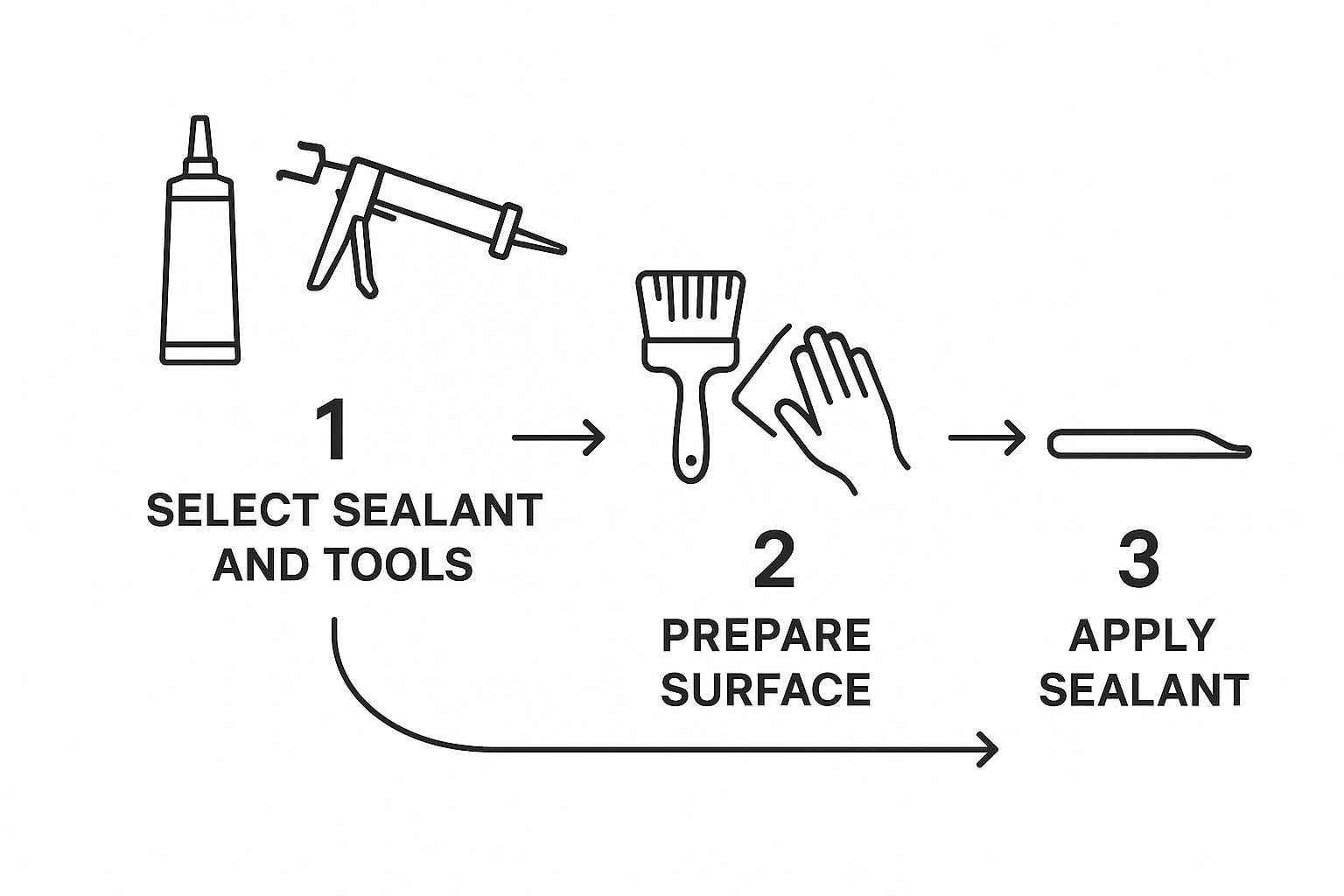
This infographic offers a simplified overview of sealing a skylight: choosing the right sealant and tools, preparing the surface, and applying the sealant. Just like following a recipe, these steps ensure a successful outcome.
Preparing the Skylight Area
Begin by ensuring safe access to your skylight with a sturdy ladder and appropriate safety equipment. Thoroughly clean the area around the skylight frame with a cleaning solution and rags. This removes dirt, debris, and any loose existing sealant. This preparation is essential for proper sealant adhesion, similar to prepping a wall before painting.
You wouldn’t paint over a dirty surface, and the same principle applies here. Debris compromises the new seal. For stubborn old sealant, carefully use a putty knife to scrape it away without damaging the skylight frame.
Applying the Sealant
Once the surface is clean, it’s time to apply the sealant. Load your caulking gun and apply a continuous bead of sealant around the skylight frame. Ensure consistent coverage and a tight seal against the frame and roofing material. For larger gaps, consider using backer rod for support, preventing the sealant from sinking too deeply.
Applying sealant correctly is similar to frosting a cake – a smooth and even application is essential. Overlapping beads and filling all gaps create a waterproof barrier.
Installing or Replacing Flashing (If Necessary)
Flashing protects your skylight from the elements, diverting water away from the frame. If your flashing is damaged or missing, now is the time to address it. Secure the flashing to the roof with roofing screws, ensuring proper overlap and sealant coverage around all edges. Properly installed flashing acts like a gutter, channeling water away effectively.
This extra protection prevents water from entering your home, even during heavy rain. For further information on skylight installation, you might find this helpful: How to master skylight installation.
Ensuring Proper Drainage and Final Inspection
After applying the sealant and flashing, check the drainage around the skylight. Water should flow freely away from the frame, preventing pooling and potential leaks. Finally, conduct a thorough inspection for any missed spots or gaps. This final check catches small errors before they become larger problems. Think of this step as proofreading an important document.
Troubleshooting and Tips for Challenging Installations
Older skylights or complex roof designs can present challenges. For tricky angles or hard-to-reach areas, a flexible nozzle extension for your caulking gun can be beneficial. Masking tape helps create clean sealant lines and prevents messy overspill. These tips can simplify the process and improve the final result.
By following these steps carefully, you can create a secure, long-lasting seal for your skylight, protecting your home and creating a more comfortable living space.
Tackling Australia’s Unique Climate Challenges
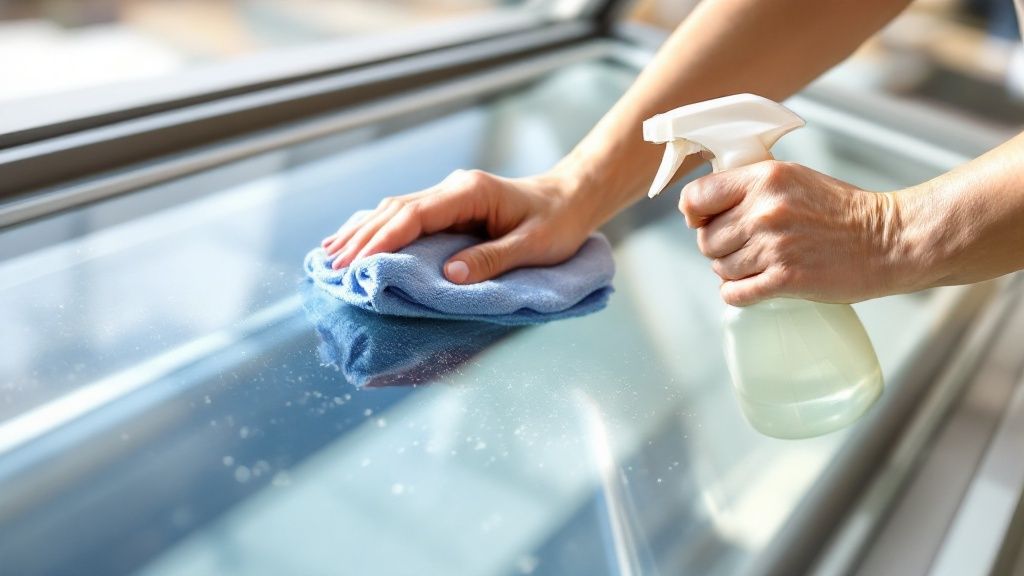
Australia’s diverse climate, from the tropical north to the temperate south, presents unique considerations for skylight sealing. A successful skylight installation depends on understanding these regional differences and adapting your approach. This means selecting appropriate materials and techniques to achieve a durable, weathertight seal.
Weatherproofing in High-Humidity Areas
In tropical regions like Queensland, high humidity and heavy rainfall necessitate robust weatherproofing. Sealants must be mould and mildew resistant and able to withstand constant moisture. The intense sunlight also requires UV-resistant materials to prevent degradation and cracking. Skylights in tropical climates must adhere to specific standards, such as the weatherproofing tests outlined in AS/NZS 4284, ensuring they can handle heavy downpours. Proper sealing is also crucial to prevent leaks during storms, a common occurrence in areas like Melbourne. Learn more about energy efficiency and skylights in Queensland’s tropical climate.
Thermal Cycling Considerations in Temperate Zones
Temperate zones, such as Melbourne, experience significant temperature fluctuations throughout the year. This thermal cycling puts stress on sealing materials, causing expansion and contraction that can lead to cracks and leaks. A flexible sealant with a wide temperature tolerance is essential for these areas. Maintaining consistent sealing quality is important and requires a well-defined process, much like using Standard Operating Procedures for Manufacturing.
UV Protection and Coastal Conditions
Much of Australia experiences intense sunlight, requiring sealants with high UV resistance. Prolonged UV exposure can degrade sealants, diminishing their effectiveness. Coastal regions face the additional challenge of salt spray, which can corrode flashing. Choosing marine-grade sealants and stainless steel flashing ensures longevity in these harsh conditions. This proactive approach minimizes future repairs and replacements.
Altitude and Timing Your Sealing Work
Altitude can also influence your sealing strategy. Higher altitudes experience greater temperature fluctuations and stronger winds. This requires more durable materials and precise installation. Timing is also crucial. Avoid sealing during temperature extremes, as this can affect sealant performance. The ideal time is during mild, dry weather for optimal curing and adhesion.
By considering these climate-specific factors, you can effectively seal your skylight, ensuring a weathertight and long-lasting result that withstands Australia’s unique environmental challenges.
Maximizing Energy Efficiency Through Smart Sealing
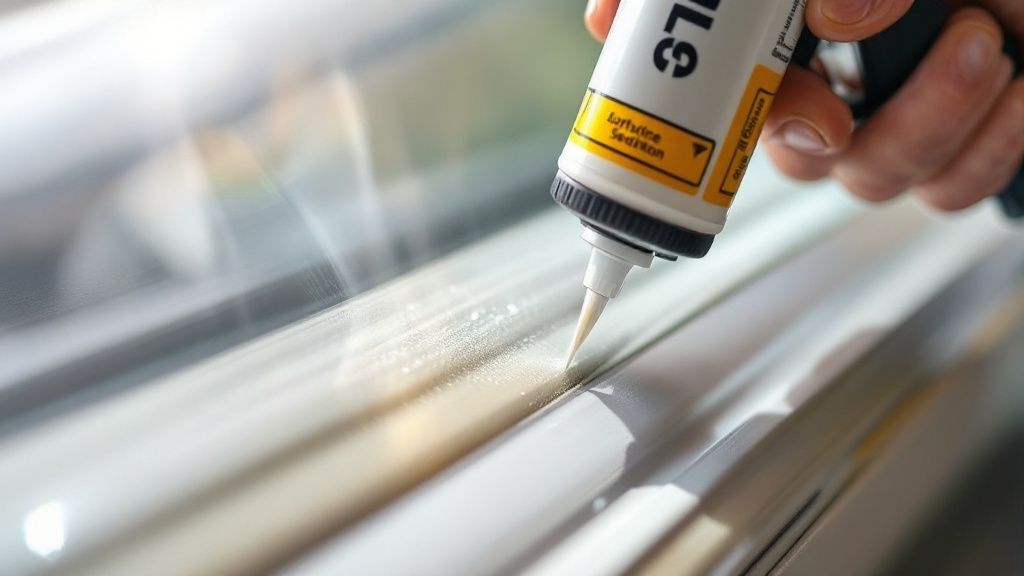
A properly sealed skylight does more than prevent leaks; it significantly boosts your home’s energy efficiency. This translates to lower energy bills and a more comfortable living space, especially important in Australia’s diverse climate. Let’s explore how airtightness impacts thermal efficiency and what you can do to optimize your skylight’s performance.
The Impact of Airtightness on Thermal Efficiency
Airtightness is crucial for preventing unwanted heat transfer. A well-sealed skylight minimizes drafts, keeping precious warm air inside during winter and blocking hot air during the summer. This reduces the strain on your heating and cooling systems, resulting in noticeable energy savings.
A drafty skylight can act like a small open window, constantly leaking conditioned air. This makes your HVAC system work harder, costing you more money.
Proper sealing also enhances the effectiveness of your insulation. Together, they create a robust thermal barrier. This is particularly important for skylights, which are often exposed to direct sunlight and fluctuating temperatures.
Given Australia’s varied weather conditions, using water-resistant products is essential for long-lasting performance. Check out waterproof labels for some ideas on ensuring effective water resistance.
The Window Energy Rating Scheme (WERS) and Your Skylight
The Window Energy Rating Scheme (WERS) assesses the energy efficiency of windows and skylights in Australia. It uses a star rating system, with more stars indicating better thermal performance. A skylight’s energy efficiency is influenced by factors like glazing and ventilation.
Skylights with Low-E or tinted coatings minimize heat gain and loss, providing excellent value for money through long-term energy savings. Find more detailed statistics here. Understanding the WERS rating can empower you to make informed decisions. For more helpful information, take a look at how to master skylight energy efficiency.
Balancing Natural Ventilation and Energy Efficiency
Operable skylights offer excellent natural ventilation. However, they can also be a source of air leakage if not sealed properly. Finding the right balance between ventilation and energy efficiency is key, particularly in warmer months.
Choosing a skylight with a robust sealing system lets you enjoy fresh air without compromising energy efficiency. By understanding these factors and selecting appropriate sealing materials and techniques, you can significantly improve your skylight’s energy performance. This contributes to a more comfortable and sustainable home.
Solving Common Problems Like a Pro
Even the most carefully installed skylight seals can occasionally experience issues. This guide offers practical troubleshooting advice for common problems Australian homeowners face, empowering you to address them with confidence.
Diagnosing the Culprit: Sealant, Flashing, or Structure?
Identifying the root of the problem is the first step toward a solution. Water leaks are the most obvious indicator, but condensation can also signal a failing seal. Condensation often manifests as moisture between glass panes or around the skylight frame. For more in-depth guidance on leaks, check out our guide on how to fix a leaking skylight.
If you spot a leak, carefully inspect the sealant around the frame. Look for cracks, gaps, or separation. Next, examine the flashing for rust, damage, or improper installation. Finally, consider potential structural shifts, especially in older homes or earthquake-prone regions. These shifts can contribute to seal failures.
Repair Strategies for Various Failure Modes
Minor sealant issues might require only thorough cleaning and a new application of high-quality, weather-resistant sealant. For instance, a simple reseal can often fix cracks caused by age.
However, damaged or corroded flashing necessitates complete replacement. This typically involves removing the old flashing, cleaning the area, and installing new flashing with proper overlap and sealant. This is crucial for long-term weather protection in the harsh Australian climate.
When to DIY and When to Call a Pro
Many minor skylight sealing problems are suitable for DIY solutions. However, if you’re unsure about the cause or the required repairs, consult a professional. This is particularly important for complex roof structures or suspected structural damage.
Preventing Future Headaches: Regular Inspections and Maintenance
Regular inspections and preventative maintenance significantly extend the lifespan of your skylight seal. Aim for inspections at least twice a year, ideally before and after the wet season.
Be vigilant for early warning signs like small cracks in the sealant or minor rust on the flashing. Addressing these promptly prevents escalation into major problems.
To help you diagnose and address sealing problems, we’ve compiled a handy troubleshooting table:
Common Skylight Sealing Problems and Solutions: This table assists in identifying and resolving typical skylight sealing issues in Australian homes.
| Problem | Symptoms | Likely Cause | DIY Solution | Professional Required |
|---|---|---|---|---|
| Water Leak | Visible water dripping | Damaged flashing or sealant | Reseal or patch if minor | Flashing replacement, structural repairs |
| Drafts | Noticeable air movement | Gaps in sealant | Apply new sealant | If complex, consult a professional |
By understanding how to diagnose and address these common issues, you can maintain your skylight in optimal condition, ensuring reliable performance for years to come.
Keeping Your Skylight Seal Strong for Years to Come
A freshly sealed skylight is a fantastic start. But maintaining that seal is key for long-term performance and preventing future problems. This means regular checks, smart cleaning, and understanding how advancements in skylight technology affect your maintenance routine. A consistent maintenance schedule will ensure your skylight remains a source of natural light and ventilation for years to come.
Simple Maintenance for Long-Lasting Seals
Just like cleaning your gutters, maintaining your skylight seal needs simple but regular attention. This involves inspecting the sealant for cracks or gaps, especially after harsh weather like hail or strong winds. Also, remove any debris around the skylight frame, as this can trap moisture and damage the seal. These small preventative steps can significantly extend the sealant’s life, avoiding major repairs later. For example, clearing leaves and branches after a storm prevents them from rotting and harming the sealant.
Inspection Techniques: Catching Problems Early
Regular inspections are vital for finding potential issues early. Learn to spot the warning signs of seal failure, like condensation between panes or water stains on your ceiling. These often come before obvious leaks, allowing you to fix the problem proactively. Also, inspect the flashing around the skylight for any rust or damage. Early detection allows for timely repairs, preventing more extensive damage later. It’s much like regularly checking your car’s oil – small preventative actions can prevent major engine trouble.
Modern Skylight Technology and Your Maintenance Approach
Skylights in Australian homes have changed over time with technology and building codes. With the focus on sustainable housing, skylights are more integrated into building designs. The development of technologies like tubular skylights and solar-powered skylights has increased their appeal for homeowners looking to boost energy efficiency and enjoy natural light. Explore this topic further. Modern skylights often use durable materials and innovative designs, improving their lifespan and reducing maintenance. However, regular inspections are still important even with these improvements.
Seasonal Maintenance: Preparing for Australia’s Weather
Australia’s varied climates need specific seasonal attention. In tropical regions, pre-wet season checks are vital. This could involve cleaning the skylight and checking the seal for any weak points. In storm-prone areas, post-storm checks are crucial for quickly finding and addressing any problems. In colder climates, ensure the sealant remains flexible and hasn’t cracked due to temperature changes. For instance, in Melbourne, preparing for both the hot summer sun and heavy winter rains is essential for maintaining your skylight’s seal.
Upgrading to Modern Sealing Systems
Regular maintenance can extend the life of your current seal. But upgrading to a modern sealing system can be a worthwhile long-term investment. New systems often provide better performance, increased durability, and potentially better energy efficiency. Innovations like solar-powered ventilation can also improve performance while maintaining a secure weatherproof seal. This allows for better airflow and temperature control, especially helpful in Australia’s warmer regions.
Ready to bring natural light into your home with a durable, high-quality skylight? Vivid Skylights offers a range of skylight solutions ideal for any Australian home. Discover the perfect Vivid Skylight for your home today!
